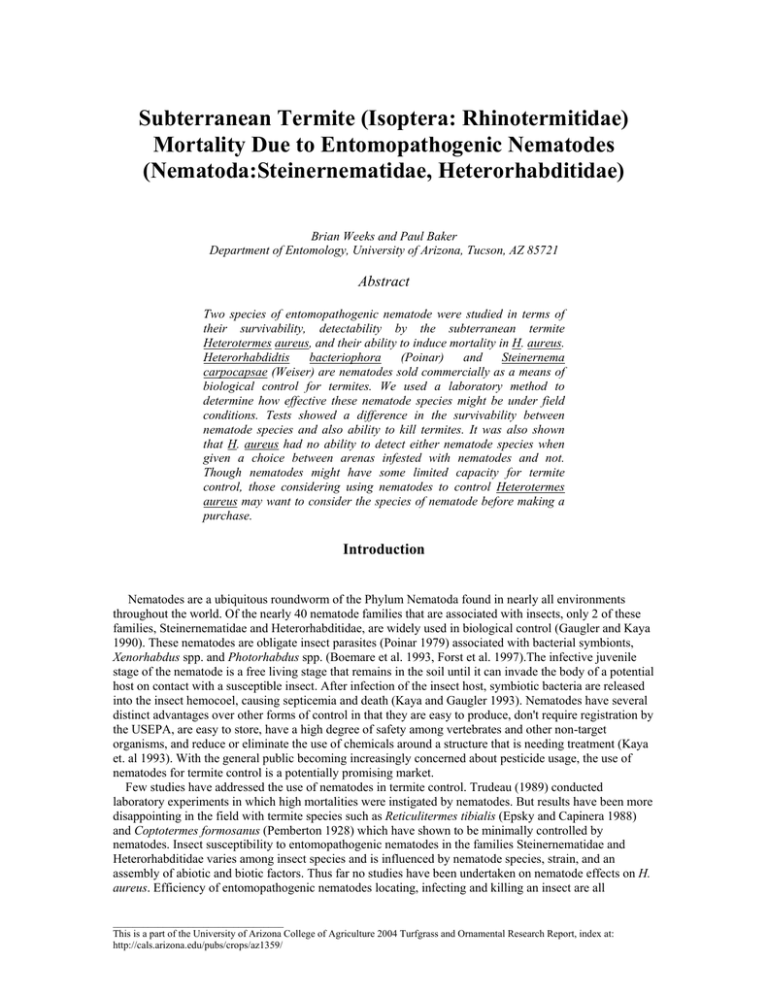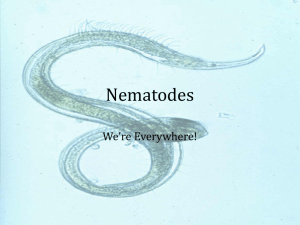Subterranean Termite (Isoptera: Rhinotermitidae) Mortality Due to Entomopathogenic Nematodes (Nematoda:Steinernematidae, Heterorhabditidae)
advertisement

Subterranean Termite (Isoptera: Rhinotermitidae) Mortality Due to Entomopathogenic Nematodes (Nematoda:Steinernematidae, Heterorhabditidae) Brian Weeks and Paul Baker Department of Entomology, University of Arizona, Tucson, AZ 85721 Abstract Two species of entomopathogenic nematode were studied in terms of their survivability, detectability by the subterranean termite Heterotermes aureus, and their ability to induce mortality in H. aureus. Heterorhabdidtis bacteriophora (Poinar) and Steinernema carpocapsae (Weiser) are nematodes sold commercially as a means of biological control for termites. We used a laboratory method to determine how effective these nematode species might be under field conditions. Tests showed a difference in the survivability between nematode species and also ability to kill termites. It was also shown that H. aureus had no ability to detect either nematode species when given a choice between arenas infested with nematodes and not. Though nematodes might have some limited capacity for termite control, those considering using nematodes to control Heterotermes aureus may want to consider the species of nematode before making a purchase. Introduction Nematodes are a ubiquitous roundworm of the Phylum Nematoda found in nearly all environments throughout the world. Of the nearly 40 nematode families that are associated with insects, only 2 of these families, Steinernematidae and Heterorhabditidae, are widely used in biological control (Gaugler and Kaya 1990). These nematodes are obligate insect parasites (Poinar 1979) associated with bacterial symbionts, Xenorhabdus spp. and Photorhabdus spp. (Boemare et al. 1993, Forst et al. 1997).The infective juvenile stage of the nematode is a free living stage that remains in the soil until it can invade the body of a potential host on contact with a susceptible insect. After infection of the insect host, symbiotic bacteria are released into the insect hemocoel, causing septicemia and death (Kaya and Gaugler 1993). Nematodes have several distinct advantages over other forms of control in that they are easy to produce, don't require registration by the USEPA, are easy to store, have a high degree of safety among vertebrates and other non-target organisms, and reduce or eliminate the use of chemicals around a structure that is needing treatment (Kaya et. al 1993). With the general public becoming increasingly concerned about pesticide usage, the use of nematodes for termite control is a potentially promising market. Few studies have addressed the use of nematodes in termite control. Trudeau (1989) conducted laboratory experiments in which high mortalities were instigated by nematodes. But results have been more disappointing in the field with termite species such as Reticulitermes tibialis (Epsky and Capinera 1988) and Coptotermes formosanus (Pemberton 1928) which have shown to be minimally controlled by nematodes. Insect susceptibility to entomopathogenic nematodes in the families Steinernematidae and Heterorhabditidae varies among insect species and is influenced by nematode species, strain, and an assembly of abiotic and biotic factors. Thus far no studies have been undertaken on nematode effects on H. aureus. Efficiency of entomopathogenic nematodes locating, infecting and killing an insect are all __________________________________ This is a part of the University of Arizona College of Agriculture 2004 Turfgrass and Ornamental Research Report, index at: http://cals.arizona.edu/pubs/crops/az1359/ profoundly affected by the host (Gouge et al. 1999). It is entirely possible that H. aureus is more or less susceptible to nematode attack in the field since environmental factors in the Southwest where H. aureus is a pest species are different than areas where control by nematodes has been tested. One of the common problems with the use of nematodes is their survivability and efficacy (Gaugler 1988). Gaugler (1988) noted the striking differences in efficacy that exist between Steinernematid and Heterorhabditid nematodes and that various species of the respective families have differing effects depending on the host infected. Epsky and Capinera (1988) also reported an ability of the subterranean termite Reticulitermes tibialis to detect and avoid Steinernema feltiae. Entomopathogenic nematodes also differ in their abilities to survive different environmental conditions. Ability to penetrate soil, method of host attack, and ability to handle environmental extremes may favor the use of a particular nematode over another (Kaya and Gaugler 1993). Nematodes must be placed in environments congenial to their survival or they prove useless for control. We tested two species of commercially available nematode for survivability, ability to produce mortality in H. aureus, and detectability by H. aureus. Since most other studies have focused on controlling the Eastern subterranean termite Reticulitermes tibialis, we hypothesised that H. aureus may react in a different way when exposed to nematodes, having evolved in a different environment. Methods Survivability. Heterorhabdidtis bacteriophora and Steinernema carpocapsae were ordered from Biological Control Systems (Tucson, Arizona) and arrived 8/11/01. They were refrigerated for 48 hours prior to use. After 48 hours the nematodes were brought to the lab for extraction. The nematodes are packaged on a sponge like material which was dipped in a 500mL beaker filled with distilled water and squeezed several times in order to release the nematodes. After the nematodes were released into the water, they were stored at room temperature (23 degrees Celsius) for 3 weeks. A 2 mL sample was extracted after 24 hours, 72 hours and from thereon weekly from the bottom of each beaker. The samples were immediately observed after extraction under a dissecting microscope. A relative number of nematodes alive or dead for each sample was determined by observing nematode motility in each sample. Mortality. Twelve plastic, cylindrical cases (5cm X 4cm) were filled with 20 grams of sterilized native soil and then moistened with 2mL-distilled water. A 2cm2 piece of filter paper was placed in each case as food for termites. One hundred H. aureus were then placed in each case. After the termites had settled into the cases, 3 mL of nematode "solution" was drawn from the bottom of the glass beaker containing nematodes. Three mL of the H. bacteriophora sample was placed in 4 cases while 3mL of S. carpocapsae was placed in 4 cases. The remaining 4 cases were used as controls with 3mL of additional distilled water being placed in each. Cases were checked after 24 hours for termite mortality. Detection (Choice Test). A two-way assay was set up using 3 of the aforementioned cases connected by tygon tubing. A 5 mm hole was burned in the side of each case using a soldering iron and then the three were connected using 4mm tygon tubing with modeling clay to seal the tubes to the case. (Fig.1) The central chamber was filled with 20 grams of sterilized soil and 2mL of distilled water. A hole was soldered in the top of the central chamber and covered with gauze for ventilation. One side of the central case was connected to another case, which contained a 2cm2 piece of filter paper, which acted as a control by wetting it with 2mL-distilled water. The other side of the central case was connected to another case containing a 2cm2 piece of filter paper moistened with 2mL of nematode solution. Twenty replications of this setup were produced, with 10 of the replications contained H. bacteriophora and 10 contained S. carpocapsae as the treatment. One hundred H. aureus were then placed in each central chamber. Data were taken after 24 and 48 hours after introduction for numbers present in each case. Figure 1 : Two-way choice Termites Filter Paper w/ nematode solution Filter Paper w/distilled water Sterilized soil Tygon Tubing Results Survivability. Twenty four hours after release into the holding beakers there appeared to be significant survival for both species. The samples from the beaker containing H. bacteriophora did have many dead nematodes but the majority were motile and alive. S. carpocapsae samples had very little mortality and almost all the nematodes appeared highly motile. Seventh two hours after release into the holding beakers the samples showed almost no surviving nematodes in the container with H. bacteriophora. Significant observation time was required in these samples before any living nematodes were found. Samples from the beaker containing S. carpocapsae revealed a majority of the nematodes still alive although there was some mortality. The surviving nematodes appeared to be of high vigor and were fully motile. Surviving S. carpocapsae numbers remained high up to 3 weeks after activation. Mortality. Mortality caused by the addition of the nematode species differed according to species (Table 1). In the treated cases containing H. bacteriophora only 40 H. aureus had died after 24 hours. In the treated cases containing S. carpocapsae all 400 termites were dead after twenty-four hours. In the controls there were only 20 H. aureus dead after 24 hours. Nematode species H. bacteriophora S. carpocapsae Controls Alive 360 0 380 Dead 40 400 20 Table 1. Mortality of H. aureus after 24 hour exposure to 2 nematode species in a no choice assay. Detection (Choice Test). After 24 hours there were more termites alive in the nematode treated cases than in the non-treated (Table 2). H. bacteriophora had a higher mean number alive ( =19.0) in the treated than S. carpocapsae ( =15.0). A few termites by this time had already perished. After 48 hours most of the introduced H. aureus had expired although most of the dead individuals were in the treated cases (Table 2). 24 hours H. bacteriophora Alive 19.0 Dead 0.8 Alive 3.3 Dead 0.7 S. carpocapsae 48 hours H. bacteriophora 15.2 Alive 0.5 0.9 Dead 24.6 4.8 Alive 0.0 0.6 Dead 5.0 S. carpocapsae 0.0 20.7 0.7 6.5 Table 2. Mean mortality and survival of H. aureus in a choice test assay to 2 nematode species after 24 and 48 hours. Discussion Whether nematodes can provide adequate termite control depends on the species used to control them. Nematode species differ in terms of their survivability. Temperature, pH, substrate and other environmental factors may all play a role in nematode survival. Our results suggest that some nematode species may need to be immediately applied after being received while with other species it may be possible to store for several days. S. carpocapsae proved to be more hearty and robust in surviving for several weeks after being received, but we do not count out the possibility that this may be due more to rearing practices of the manufacturer than a biological trait of the species. S. carpocapsae also proved more potent in causing H. aureus mortality than H. bacteriophora, which could be directly linked to the survivability of both species. There was no evidence in this study that H. aureus has an ability to detect nematodes of either species. Epinasky and Capinera (1988) reported an avoidance of nematodes by R. tibialis. Because there were more H. aureus in the nematode infested cases which resulted in their death after 48 hours, this suggests that either H aureus differs from other termite species such as R. tibialis in that they lack a detection mechanism or it could be that instead of termites having the ability to detect nematodes they instead are able to detect other termites that have died from nematode infestation. References Cited Boemere, N. E., R. J. Akhurst, and R. G. Mourant. 1993. DNA relatedness between Xenorhabdus spp. (Enterobacteriacae), symbiotic bacteria of entomopathogenic nematodes, and a proposal to transfer Xenorhabdus luminescens to a new genus, Photorhabdus gen. Nov. Int. J. Syst. Bacteriol. 43:249-255. Epsky, N. and J. L. Capinera. 1988. Efficacy of the entomogenous nematode Steinernema feltiae against a subterranean termite, Reticulitermes tibialis (Isoptera: Rhinotermitidae). J. Econ. Entomol., 8. Forst, S., B. Dowds, N.Boemare, and E. Stackebrandt. 1997. Xenorhabdus and Protorhabdus spp.: Bugs that kill bugs. Annu. Rev. Microbiol. 51:47-72. Gaugler, R. 1988. Ecological Considerations in the Biological Control of Soil-inhabiting Insects with Entomopathogenic Nematodes. Agric. Ecosystems Environ., 24:351360. Gaugler, R and H. K. Kaya, Eds.. 1990. Entomopathogenic Nematodes in Biological Control. CRC Press 365 pp. Gouge, D. H., L. L. Lee, and T. J. Henneberry. 1999. Effect of temperature and lepidopteran host species on entomopathogenic nematode (Nematoda:Steinernematidae, Heterorhabditidae) Infection. Biological Control 28(5):876-883. Kaya, H. K. and R. Gaugler. 1993. Entomopathogenic Nematodes. Annu. Rev. Entomol. 38:181-206. Pemberton, C. E. 1928. Nematodes associated with termited in Hawaii, Borneo and Celebes. Proceedings of the Hawaiian Entomological Society 7, 147. Poinar, G.O., Jr. 1979. The natural history of nematodes. Prentice-Hall, Englewood Cliffs, NJ. Trudeau, D. 1989. Selection of entomophilic nematodes for control of the eastern subterranean termite, Reticulitermes flavipes (Kollar) (Isoptera: Rhinotermitidae). 93 pp. Master's thesis, University of Toronto, Toronto, Ontario, Canada.






